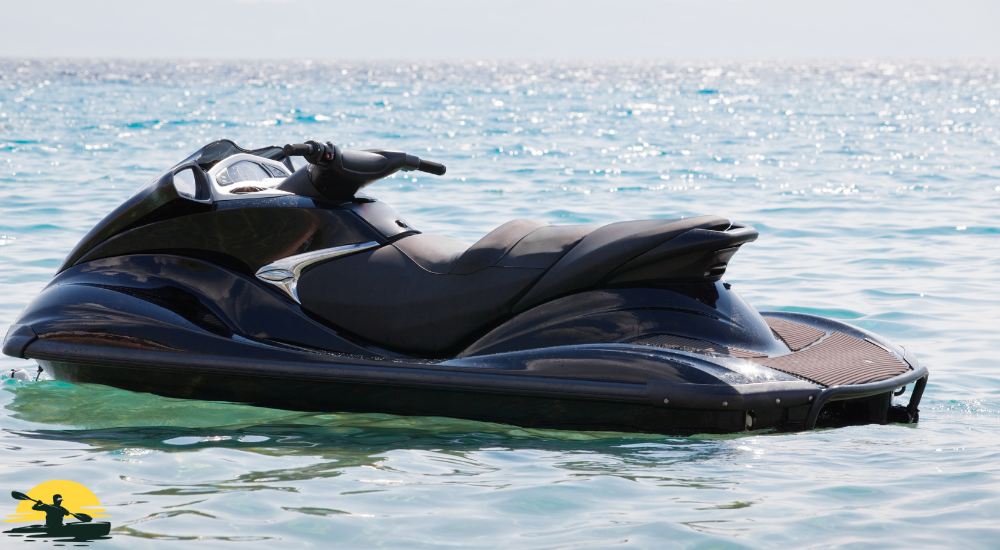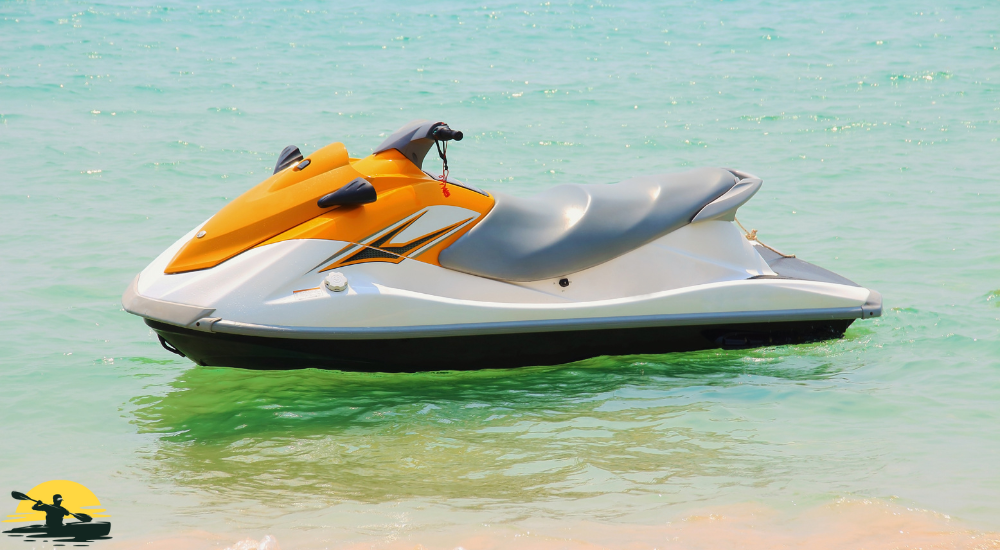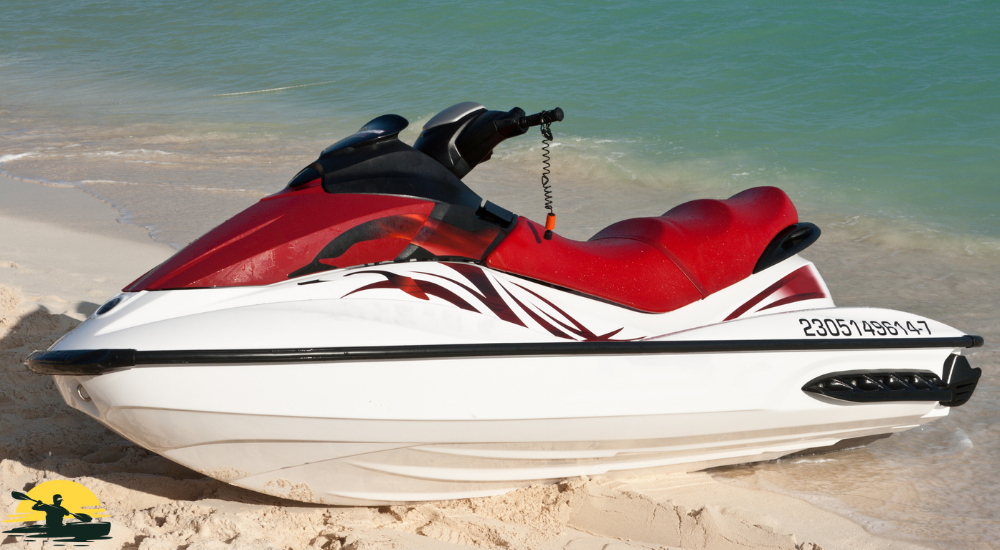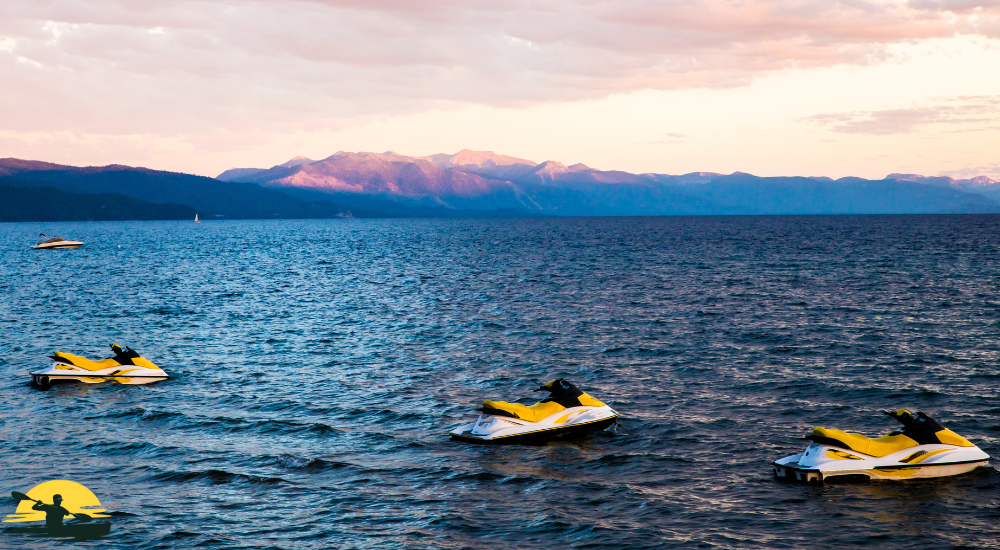
Summer’s over, and it’s time to tuck your jet ski away for winter.
But before you do, you need to protect it from the cold weather, which can be tough on the gas tank and other parts. The solution? Winterize it!
This guide will show you step-by-step how to get your jet ski ready for its long winter nap. We’ll cover everything you need, like using a fuel stabilizer, so you can do it yourself and save money.
How to Winterize Your Jet Ski in
- Why bother? Winterizing prevents damage from freezing, rust, and old fuel. It’s like putting a winter coat on your jet ski!
- Gather your supplies: Fuel stabilizer, fogging oil (maybe), antifreeze, lubricant, battery charger, and some basic tools.
- Step 1: Clean your jet ski, especially if it’s been in saltwater.
- Step 2: Add fuel stabilizer, fill the gas tank, and run the engine for a bit.
- Step 3: Fog the engine (if needed) and spray some oil in the spark plug cylinders.
- Step 4: Drain the cooling system and refill it with antifreeze.
- Extra credit: Lubricate moving parts, disconnect the battery and connect it to a charger, put dryer sheets inside to keep critters out, and use premium gas in the tank.
- Tuck it in. Store your jet ski indoors if possible, or cover it up if it’s outside. Keep it level and off the ground.
- Spring is coming: Get ready to de-winterize and have fun when the warm weather returns!
Why Winterize Your Jet Ski?
Winter is coming, and while your jet ski might be ready for a break, the cold weather can wreak havoc on it if you don’t prepare it properly.
Think of it like putting on a warm coat and hat – your jet ski needs some winter gear, too!
Here’s why winterization is important:

- Frozen water = cracked parts: Freezing temperatures can turn any leftover water inside your jet ski into ice. And, like when you freeze a water bottle, that ice expands. This expansion can crack and break parts in your engine, cooling system, exhaust system, or even the storage compartments. Starting summer with a repair bill is no fun!
- Old fuel = engine problems: Leaving old fuel sitting in your jet ski’s gas tank can cause it to go bad and lead to problems when you try to start it up again in the spring. This is similar to how old gas can mess up a lawnmower.
- Moisture = rust and damage: Moisture can sneak into places it shouldn’t, like the air filter or spark plugs, causing rust and other damage. Think of it like leaving a metal bike outside in the rain – it starts to rust!
You need to winterize your jet ski to ensure it is ready to hit the waves when the sun comes back out.
This involves a few steps, like adding a fuel stabilizer, spraying fogging oil to protect the engine, draining and refilling the cooling system with an antifreeze mixture, and disconnecting the jet ski battery.
But don’t worry! It’s easier than it sounds. With this guide, we’ll walk you through each step so you can do it yourself and save some money.
Gather Your Supplies
Alright, before you winterize your jet ski, let’s make sure you have everything you need. It’s like packing for a trip—you don’t want to forget anything important!
Here’s your checklist:
- Fuel Stabilizer: This magic potion keeps the gas in your jet ski tank from going bad over the winter. Think of it like a preservative for your fuel.
- Fogging Oil (if needed): This special oil coats the inside of your engine to protect it from rust. Not all jet skis need this, so check your owner’s manual to see if yours does.
- Anti-Freeze/Coolant: Just like in your car, antifreeze keeps the water in your jet ski’s cooling system from freezing and causing damage. Make sure to get the kind that’s made for jet skis or boats, not cars.
- Lubricant/Protectant Spray: This helps keep all the moving parts on your jet ski happy by preventing rust and corrosion.
- Battery Charger/Maintainer: This handy gadget keeps your jet ski’s battery charged while it’s in storage, so it’s ready to go in the spring.
- Engine Flush Kit (optional): This helps you clean out the gunk from your engine before you put it away for winter. It’s like giving your jet ski a bath on the inside.
- Basic Tools: To get the job done, you’ll need wrenches, screwdrivers, and maybe a socket set. If you don’t have these, you can usually borrow them from a friend or family member.
- A Few Extras:
- A funnel to make pouring fluids easier.
- A rag or two for wiping up spills.
- A bucket to catch any drained fluids.
- Dryer sheets to keep critters out of your jet ski during storage (they don’t like the smell).

You can find all these things at your local marine store or even some auto parts stores. If you’re not sure what to get, don’t be afraid to ask for help – they’ll be happy to point you in the right direction.
Once you’ve gathered your supplies, it’s time to move on to the next step—actually winterizing your jet ski! Don’t worry—it’s easier than you might think.
Winterizing Your Jet Ski
Alright, it’s time to roll up your sleeves and get your hands a little dirty. But don’t worry; with these easy-to-follow steps, you’ll have your jet ski winterized in no time.
Just think of it like giving your jet ski a cozy bed for the winter!
1: Give Your Jet Ski a Bath (Optional)
If your jet ski has been in saltwater, give it a good wash with fresh water. This helps get rid of salt and grime that could cause problems later on. It’s like taking a shower after swimming in the ocean.
2: Fuel System Prep
- Add Fuel Stabilizer: Follow the directions on the bottle and add the right amount of fuel stabilizer to your jet ski’s gas tank. This stuff keeps your fuel from going bad over the winter.
- Fill ‘Er Up Top off your gas tank completely. This helps prevent moisture from building up inside.
- Run the Engine: Start up your jet ski and let it run for a few minutes to get that stabilized fuel flowing through the system. Just like stretching before exercise, this gets everything warmed up and ready for the next step.
3: Protect the Engine
- Fogging Oil (If Needed): If your owner’s manual says to use fogging oil, now’s the time. Spray it into the air intake while the engine is running until it stalls. This coats the inside of the engine and prevents rust.
- Spark Plugs: Take out the spark plugs and spray a little fogging oil into each cylinder. This gives those parts an extra layer of protection.
4: Cooling System Care

- Drain the Water: Find the drain plugs on your jet ski (check your owner’s manual if you’re not sure where they are). Open them up and let all the water drain out. It’s like emptying the bathtub.
- Antifreeze Time: Close the drain plugs and fill the cooling system with the right kind of antifreeze. This keeps any leftover water from freezing and causing damage.
And that’s it for the main steps! There are a few more things you can do to give your jet ski extra protection, but these are the basics.
If you follow these steps, your jet ski will be sleeping soundly until it’s time to hit the water again next year.
Tips to Keep Your Jet Ski Happy
You’ve completed the main steps for winterizing your jet ski, and it looks good!
But a few extra touches can help it stay in tip-top shape until next season. Think of these as giving your jet ski some extra blankets to keep warm.
- Lubricate Everything: Spray lubricant on all the moving parts you can find—things like the steering cable, throttle cable, and any joints or hinges. This helps prevent rust and ensures smooth operation when you’re ready to ride again.
- Battery TLC: Disconnect your jet ski battery and hook it up to a battery maintainer (or trickle charger). This keeps it charged up over the winter, just like plugging in your phone to charge it overnight. Remember to disconnect the negative terminal first, then the positive.
- Critter Control: Mice and other critters love to make nests in jet skis over the winter. Yuck! To keep them out, put a few dryer sheets inside the storage compartments and under the seat. The smell keeps them away. You can also try peppermint spray – critters hate that too!
- Premium Gas Only: When you filled up your gas tank earlier, make sure you used premium gas. It has less ethanol, which can cause problems in your engine if it sits for a long time.
- Check Fluids: Top off any other fluids, like brake fluid or oil, if they’re low. It’s like making sure you have enough milk in the fridge before going on vacation.
If You Have a 4-stroke Engine
- Change the Oil: Fresh oil helps keep your engine clean and running smoothly. You can do this yourself or have a mechanic do it for you. It’s like getting an oil change for your car.
- Check the Filter: If your jet ski has an oil filter, now’s a good time to replace it too. It’s like cleaning the lint trap in your dryer.
If You Have a 2-Stroke Engine
- Drain the Carburetor: This gets rid of any leftover fuel that could cause problems later on. It’s like cleaning your plate after dinner.
Even though winterizing your jet ski seems like a lot of work, it’s pretty simple.
It’s worth it to protect your investment and ensure that you’re ready for fun in the sun next year!
Tucking Your Jet Ski in for Winter
Congrats! You’ve made it through the winterization process.
Your jet ski is now protected and ready for its winter slumber. Here are the final steps to make sure it stays cozy and safe:

Storage
- Find a Good Spot: If possible, store your jet ski indoors, like in a garage or shed. This protects it from the elements. If you have to store it outside, cover it with a breathable jet ski cover to keep out rain, snow, and dirt.
- Keep it Level: Make sure your jet ski is sitting level. If it’s tilted, fluids might not drain properly, and that could lead to problems.
- Block it Up: Put blocks or stands under the hull of your jet ski to keep it off the ground. This helps prevent moisture from building up underneath and causing rust.
One Last Check
- Double Check Fluids: Before you cover your jet ski up, take one last look to make sure all the fluids are topped off (oil, brake fluid, etc.).
- Tighten Everything: Give all the screws, bolts, and clamps a quick check to make sure everything is snug and secure.
- Fuel Valve: If your jet ski has a fuel valve, turn it to the “off” position. This prevents fuel from leaking into the engine.
Springtime Prep (Just a Sneak Peek)
When warm weather rolls around again, you’ll need to de-winterize your jet ski before you can hit the water.
This involves basically reversing the steps you just took. Don’t worry, though; we’ll cover all that in another guide to help you get ready for spring fun.
And that’s a wrap! You’ve successfully winterized your jet ski and saved yourself some serious headaches (and money) down the road. Now, you can rest easy knowing your jet ski is safe and sound until next season.
Conclusion

So, there you have it! You’ve successfully winterized your jet ski and protected your investment.
By properly preparing your jet ski for the off-season, you’ve ensured that it’s ready to go when the warm weather returns. Remember, winterizing isn’t just about fuel stabilizers and fogging oil. It’s about paying attention to every detail to prevent costly repairs.
By following this step-by-step guide, you’ve taken the necessary precautions to ensure that your jet ski will be running smoothly when you’re ready to take it out of storage.
So, kick back, relax, and enjoy your winter, knowing that your jet ski is safe and sound. And when the sun starts shining again, you’ll be ready to hit the waves without a worry!
Frequently Asked Questions
Can I winterize my jet ski myself, or should I hire a professional?
While winterizing a jet ski is a task you can DIY with the right tools and information, some people prefer to leave it to the pros for peace of mind. If you need to be more comfortable working on engines, handling flammable substances, or using tools like a flush outlet, consider hiring a professional to winterize your jet ski properly.
What type of fuel stabilizer should I use to prevent fuel contamination?
Always choose a fuel injection system for marine engines. These stabilizers are formulated to prevent fuel breakdown, keep the fuel system clean, and avoid fuel contamination, which is essential for ensuring easy starting in the spring.
Do I need to use fogging oil on my jet ski?
Whether you need to spray fogging oil into the spark plug cylinders depends on your jet ski model and engine type. You can consult your owner’s manual for specific recommendations. In general, fogging oil is recommended for two-stroke engine stalls to prevent rust and corrosion in the cylinders during storage.
How do I store my jet ski battery during the winter?
Disconnect the battery and store it in a cool, dry place. Ideally, connect it to an automatic battery charger or maintainer to keep it charged throughout the winter and prevent damage to the electrical components. Remember to disconnect the negative terminal first, then the positive.
What’s the best way to protect my jet ski during outdoor storage?
If you must store your jet ski outdoors, invest in a high-quality, breathable cover to protect it from the elements. Elevate the jet ski on blocks or a trailer to keep it off the ground, and consider using a fuel stabilizer to prevent fuel breakdown. Also, could you stuff dryer sheets in storage compartments and cover air intakes and exhaust outlets with steel wool to deter pests?










